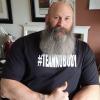-
Posts
9,088 -
Joined
-
Last visited
Reputation Activity
-
 Chuck got a reaction from Archi in HM Cutter Cheerful 1806 by Chuck - FINISHED - 1:48 scale - kit prototype
Chuck got a reaction from Archi in HM Cutter Cheerful 1806 by Chuck - FINISHED - 1:48 scale - kit prototype
Today I wanted to get the crappy part out of the way. What a mess. Fairing the outside of the hull before I start putting in the port sills.
Lots of saw dust. You folks are very familiar with this. Even with a smaller hull it took the whole day. This is the single most important part of the project. Unfortunately because its such a pain its easy to understand why people rush through it only to have issues later on.
At the bow is the usual "Bow filler piece" and a few horizontal pieces which is where the forward port will reside. Fairing the bow was challenging. Whenever you think its done...its really not. This is easy to spot using a batten. I dont angle my rabbet for the planking until this stage. And its important. Most folks angle the rabbet before gluing the bulkheads into the former. But I can never get the angles right. Its easier for me to visualize when fairing the bow and inserting battens every now and again to see how they fit.
Before fairing
After a good start at fairing the bow. Notice how the bulkhead former within the rabbet is faired to match the angle of the bow filler after its faired. If you dont do this then the plank wont fit nicely into the rabbet and defeats the purpose of having one to begin with. This is what takes lots of time. Small chisels nd sanding sticks...the usual suspects to do it. I am using the laser char on the bulkhead edges to check how the fairing is progressing as I work towards mid ship. Then I switch around and work from the stern to midship again to complete the fairing.
Here are some battens added to check the run of the port sills. There are laser reference marks on each bulkhead as is usually the case. After some careful adjustments the top of the batten was marked off on each bulkhead edge to indicate the top of the port sills. Notice how the batten fits into the rabbet and because of how its faired, I didnt have to even pre bend this strip. It lays in there perfectly and no pins are used to hold it in the rabbet. That will make planking so much easier.....which would have been a fight if I didnt take my time with this fairing. I am gald its all done, but I can still see some spots...
Tomorrow I will add the port sills and port framing before starting on the stern framing.
-
 Chuck got a reaction from tlevine in HM Cutter Cheerful 1806 by Chuck - FINISHED - 1:48 scale - kit prototype
Chuck got a reaction from tlevine in HM Cutter Cheerful 1806 by Chuck - FINISHED - 1:48 scale - kit prototype
That absolutely works for me.....makes as much sense as any other theory I have thought of. That would mean Cheerful had no lids but probably had a rabbet so bucklers could be used in rough waters. Thats my story and I am sticking to it.
-
 Chuck got a reaction from Elmer Cornish in HM Cutter Cheerful 1806 by Chuck - FINISHED - 1:48 scale - kit prototype
Chuck got a reaction from Elmer Cornish in HM Cutter Cheerful 1806 by Chuck - FINISHED - 1:48 scale - kit prototype
Today I wanted to get the crappy part out of the way. What a mess. Fairing the outside of the hull before I start putting in the port sills.
Lots of saw dust. You folks are very familiar with this. Even with a smaller hull it took the whole day. This is the single most important part of the project. Unfortunately because its such a pain its easy to understand why people rush through it only to have issues later on.
At the bow is the usual "Bow filler piece" and a few horizontal pieces which is where the forward port will reside. Fairing the bow was challenging. Whenever you think its done...its really not. This is easy to spot using a batten. I dont angle my rabbet for the planking until this stage. And its important. Most folks angle the rabbet before gluing the bulkheads into the former. But I can never get the angles right. Its easier for me to visualize when fairing the bow and inserting battens every now and again to see how they fit.
Before fairing
After a good start at fairing the bow. Notice how the bulkhead former within the rabbet is faired to match the angle of the bow filler after its faired. If you dont do this then the plank wont fit nicely into the rabbet and defeats the purpose of having one to begin with. This is what takes lots of time. Small chisels nd sanding sticks...the usual suspects to do it. I am using the laser char on the bulkhead edges to check how the fairing is progressing as I work towards mid ship. Then I switch around and work from the stern to midship again to complete the fairing.
Here are some battens added to check the run of the port sills. There are laser reference marks on each bulkhead as is usually the case. After some careful adjustments the top of the batten was marked off on each bulkhead edge to indicate the top of the port sills. Notice how the batten fits into the rabbet and because of how its faired, I didnt have to even pre bend this strip. It lays in there perfectly and no pins are used to hold it in the rabbet. That will make planking so much easier.....which would have been a fight if I didnt take my time with this fairing. I am gald its all done, but I can still see some spots...
Tomorrow I will add the port sills and port framing before starting on the stern framing.
-
 Chuck got a reaction from CharlieZardoz in HM Cutter Cheerful 1806 by Chuck - FINISHED - 1:48 scale - kit prototype
Chuck got a reaction from CharlieZardoz in HM Cutter Cheerful 1806 by Chuck - FINISHED - 1:48 scale - kit prototype
I absolutely agree and I thought the same thing. BUT....then I found these. All contemporary and from the same time period. I have dozens more with and without port lids. I guess we shall never know. I will add the rabbet......and have no lids. That is a safe bet I think.
Chuck
-
 Chuck got a reaction from fatih79 in HM Cutter Cheerful 1806 by Chuck - FINISHED - 1:48 scale - kit prototype
Chuck got a reaction from fatih79 in HM Cutter Cheerful 1806 by Chuck - FINISHED - 1:48 scale - kit prototype
Today I wanted to get the crappy part out of the way. What a mess. Fairing the outside of the hull before I start putting in the port sills.
Lots of saw dust. You folks are very familiar with this. Even with a smaller hull it took the whole day. This is the single most important part of the project. Unfortunately because its such a pain its easy to understand why people rush through it only to have issues later on.
At the bow is the usual "Bow filler piece" and a few horizontal pieces which is where the forward port will reside. Fairing the bow was challenging. Whenever you think its done...its really not. This is easy to spot using a batten. I dont angle my rabbet for the planking until this stage. And its important. Most folks angle the rabbet before gluing the bulkheads into the former. But I can never get the angles right. Its easier for me to visualize when fairing the bow and inserting battens every now and again to see how they fit.
Before fairing
After a good start at fairing the bow. Notice how the bulkhead former within the rabbet is faired to match the angle of the bow filler after its faired. If you dont do this then the plank wont fit nicely into the rabbet and defeats the purpose of having one to begin with. This is what takes lots of time. Small chisels nd sanding sticks...the usual suspects to do it. I am using the laser char on the bulkhead edges to check how the fairing is progressing as I work towards mid ship. Then I switch around and work from the stern to midship again to complete the fairing.
Here are some battens added to check the run of the port sills. There are laser reference marks on each bulkhead as is usually the case. After some careful adjustments the top of the batten was marked off on each bulkhead edge to indicate the top of the port sills. Notice how the batten fits into the rabbet and because of how its faired, I didnt have to even pre bend this strip. It lays in there perfectly and no pins are used to hold it in the rabbet. That will make planking so much easier.....which would have been a fight if I didnt take my time with this fairing. I am gald its all done, but I can still see some spots...
Tomorrow I will add the port sills and port framing before starting on the stern framing.
-
 Chuck got a reaction from Trussben in HM Cutter Cheerful 1806 by Chuck - FINISHED - 1:48 scale - kit prototype
Chuck got a reaction from Trussben in HM Cutter Cheerful 1806 by Chuck - FINISHED - 1:48 scale - kit prototype
That absolutely works for me.....makes as much sense as any other theory I have thought of. That would mean Cheerful had no lids but probably had a rabbet so bucklers could be used in rough waters. Thats my story and I am sticking to it.
-
 Chuck got a reaction from lb0190 in HM Cutter Cheerful 1806 by Chuck - FINISHED - 1:48 scale - kit prototype
Chuck got a reaction from lb0190 in HM Cutter Cheerful 1806 by Chuck - FINISHED - 1:48 scale - kit prototype
Today I wanted to get the crappy part out of the way. What a mess. Fairing the outside of the hull before I start putting in the port sills.
Lots of saw dust. You folks are very familiar with this. Even with a smaller hull it took the whole day. This is the single most important part of the project. Unfortunately because its such a pain its easy to understand why people rush through it only to have issues later on.
At the bow is the usual "Bow filler piece" and a few horizontal pieces which is where the forward port will reside. Fairing the bow was challenging. Whenever you think its done...its really not. This is easy to spot using a batten. I dont angle my rabbet for the planking until this stage. And its important. Most folks angle the rabbet before gluing the bulkheads into the former. But I can never get the angles right. Its easier for me to visualize when fairing the bow and inserting battens every now and again to see how they fit.
Before fairing
After a good start at fairing the bow. Notice how the bulkhead former within the rabbet is faired to match the angle of the bow filler after its faired. If you dont do this then the plank wont fit nicely into the rabbet and defeats the purpose of having one to begin with. This is what takes lots of time. Small chisels nd sanding sticks...the usual suspects to do it. I am using the laser char on the bulkhead edges to check how the fairing is progressing as I work towards mid ship. Then I switch around and work from the stern to midship again to complete the fairing.
Here are some battens added to check the run of the port sills. There are laser reference marks on each bulkhead as is usually the case. After some careful adjustments the top of the batten was marked off on each bulkhead edge to indicate the top of the port sills. Notice how the batten fits into the rabbet and because of how its faired, I didnt have to even pre bend this strip. It lays in there perfectly and no pins are used to hold it in the rabbet. That will make planking so much easier.....which would have been a fight if I didnt take my time with this fairing. I am gald its all done, but I can still see some spots...
Tomorrow I will add the port sills and port framing before starting on the stern framing.
-
 Chuck got a reaction from sonicmcdude in HM Cutter Cheerful 1806 by Chuck - FINISHED - 1:48 scale - kit prototype
Chuck got a reaction from sonicmcdude in HM Cutter Cheerful 1806 by Chuck - FINISHED - 1:48 scale - kit prototype
Today I wanted to get the crappy part out of the way. What a mess. Fairing the outside of the hull before I start putting in the port sills.
Lots of saw dust. You folks are very familiar with this. Even with a smaller hull it took the whole day. This is the single most important part of the project. Unfortunately because its such a pain its easy to understand why people rush through it only to have issues later on.
At the bow is the usual "Bow filler piece" and a few horizontal pieces which is where the forward port will reside. Fairing the bow was challenging. Whenever you think its done...its really not. This is easy to spot using a batten. I dont angle my rabbet for the planking until this stage. And its important. Most folks angle the rabbet before gluing the bulkheads into the former. But I can never get the angles right. Its easier for me to visualize when fairing the bow and inserting battens every now and again to see how they fit.
Before fairing
After a good start at fairing the bow. Notice how the bulkhead former within the rabbet is faired to match the angle of the bow filler after its faired. If you dont do this then the plank wont fit nicely into the rabbet and defeats the purpose of having one to begin with. This is what takes lots of time. Small chisels nd sanding sticks...the usual suspects to do it. I am using the laser char on the bulkhead edges to check how the fairing is progressing as I work towards mid ship. Then I switch around and work from the stern to midship again to complete the fairing.
Here are some battens added to check the run of the port sills. There are laser reference marks on each bulkhead as is usually the case. After some careful adjustments the top of the batten was marked off on each bulkhead edge to indicate the top of the port sills. Notice how the batten fits into the rabbet and because of how its faired, I didnt have to even pre bend this strip. It lays in there perfectly and no pins are used to hold it in the rabbet. That will make planking so much easier.....which would have been a fight if I didnt take my time with this fairing. I am gald its all done, but I can still see some spots...
Tomorrow I will add the port sills and port framing before starting on the stern framing.
-
 Chuck got a reaction from WackoWolf in HM Cutter Cheerful 1806 by Chuck - FINISHED - 1:48 scale - kit prototype
Chuck got a reaction from WackoWolf in HM Cutter Cheerful 1806 by Chuck - FINISHED - 1:48 scale - kit prototype
Yes Alistair...that is exactly what a buckler is. I have seen bucklers in many configurations. For example...sometimes a half lid was hinged on the bottom of the port opening and the buckler used only on the top half. In other instances the buckler was full size for the port. They are usually temporarily secured by ring bolts on the inboard side of the buckler and tied off to ring bolts on the bulwarks. Even the same ring bolts used for the breech line of the cannon or the gun tackles.
-
 Chuck got a reaction from KenW in HM Cutter Cheerful 1806 by Chuck - FINISHED - 1:48 scale - kit prototype
Chuck got a reaction from KenW in HM Cutter Cheerful 1806 by Chuck - FINISHED - 1:48 scale - kit prototype
That absolutely works for me.....makes as much sense as any other theory I have thought of. That would mean Cheerful had no lids but probably had a rabbet so bucklers could be used in rough waters. Thats my story and I am sticking to it.
-
 Chuck got a reaction from Archi in HM Cutter Cheerful 1806 by Chuck - FINISHED - 1:48 scale - kit prototype
Chuck got a reaction from Archi in HM Cutter Cheerful 1806 by Chuck - FINISHED - 1:48 scale - kit prototype
I absolutely agree and I thought the same thing. BUT....then I found these. All contemporary and from the same time period. I have dozens more with and without port lids. I guess we shall never know. I will add the rabbet......and have no lids. That is a safe bet I think.
Chuck
-
 Chuck got a reaction from Archi in HM Cutter Cheerful 1806 by Chuck - FINISHED - 1:48 scale - kit prototype
Chuck got a reaction from Archi in HM Cutter Cheerful 1806 by Chuck - FINISHED - 1:48 scale - kit prototype
As I am about to start framing the ports, I would like to have a bit of a discussion about the. Please feel free to chime in if this is something you are familiar with. I have seen cutters with and without port lids in paintings and drawings. I am talking about 1800-1830ish. My issue is that I have never or rarely seen a contemporary model or set of plans with port lids. I am already resolved not to show them on Cheerful.
BUT, that leads to my question. On many contemporary models I can see the rabbet around the port opening. On others still there is no rabbet. I can only assume there wasnt and standard with this. Maybe some sort of buckler was used rather than a port lid. But then why some models without a rabbet.
I have yet to decide if I should show this feature of a rabbet around the sides and bottom of the port openings.
Cheerful in the rogers collection has them
This contemporary model does not...except at the bottom maybe...
All of the others from this period that I have seen have no rabbets.
Any thoughts or research out there to help me in my decision? Thanks in advance.
-
 Chuck got a reaction from riverboat in HM Cutter Cheerful 1806 by Chuck - FINISHED - 1:48 scale - kit prototype
Chuck got a reaction from riverboat in HM Cutter Cheerful 1806 by Chuck - FINISHED - 1:48 scale - kit prototype
Today I wanted to get the crappy part out of the way. What a mess. Fairing the outside of the hull before I start putting in the port sills.
Lots of saw dust. You folks are very familiar with this. Even with a smaller hull it took the whole day. This is the single most important part of the project. Unfortunately because its such a pain its easy to understand why people rush through it only to have issues later on.
At the bow is the usual "Bow filler piece" and a few horizontal pieces which is where the forward port will reside. Fairing the bow was challenging. Whenever you think its done...its really not. This is easy to spot using a batten. I dont angle my rabbet for the planking until this stage. And its important. Most folks angle the rabbet before gluing the bulkheads into the former. But I can never get the angles right. Its easier for me to visualize when fairing the bow and inserting battens every now and again to see how they fit.
Before fairing
After a good start at fairing the bow. Notice how the bulkhead former within the rabbet is faired to match the angle of the bow filler after its faired. If you dont do this then the plank wont fit nicely into the rabbet and defeats the purpose of having one to begin with. This is what takes lots of time. Small chisels nd sanding sticks...the usual suspects to do it. I am using the laser char on the bulkhead edges to check how the fairing is progressing as I work towards mid ship. Then I switch around and work from the stern to midship again to complete the fairing.
Here are some battens added to check the run of the port sills. There are laser reference marks on each bulkhead as is usually the case. After some careful adjustments the top of the batten was marked off on each bulkhead edge to indicate the top of the port sills. Notice how the batten fits into the rabbet and because of how its faired, I didnt have to even pre bend this strip. It lays in there perfectly and no pins are used to hold it in the rabbet. That will make planking so much easier.....which would have been a fight if I didnt take my time with this fairing. I am gald its all done, but I can still see some spots...
Tomorrow I will add the port sills and port framing before starting on the stern framing.
-
 Chuck got a reaction from aliluke in HM Cutter Cheerful 1806 by Chuck - FINISHED - 1:48 scale - kit prototype
Chuck got a reaction from aliluke in HM Cutter Cheerful 1806 by Chuck - FINISHED - 1:48 scale - kit prototype
Yes Alistair...that is exactly what a buckler is. I have seen bucklers in many configurations. For example...sometimes a half lid was hinged on the bottom of the port opening and the buckler used only on the top half. In other instances the buckler was full size for the port. They are usually temporarily secured by ring bolts on the inboard side of the buckler and tied off to ring bolts on the bulwarks. Even the same ring bolts used for the breech line of the cannon or the gun tackles.
-
 Chuck got a reaction from Trussben in HM Cutter Cheerful 1806 by Chuck - FINISHED - 1:48 scale - kit prototype
Chuck got a reaction from Trussben in HM Cutter Cheerful 1806 by Chuck - FINISHED - 1:48 scale - kit prototype
Today I wanted to get the crappy part out of the way. What a mess. Fairing the outside of the hull before I start putting in the port sills.
Lots of saw dust. You folks are very familiar with this. Even with a smaller hull it took the whole day. This is the single most important part of the project. Unfortunately because its such a pain its easy to understand why people rush through it only to have issues later on.
At the bow is the usual "Bow filler piece" and a few horizontal pieces which is where the forward port will reside. Fairing the bow was challenging. Whenever you think its done...its really not. This is easy to spot using a batten. I dont angle my rabbet for the planking until this stage. And its important. Most folks angle the rabbet before gluing the bulkheads into the former. But I can never get the angles right. Its easier for me to visualize when fairing the bow and inserting battens every now and again to see how they fit.
Before fairing
After a good start at fairing the bow. Notice how the bulkhead former within the rabbet is faired to match the angle of the bow filler after its faired. If you dont do this then the plank wont fit nicely into the rabbet and defeats the purpose of having one to begin with. This is what takes lots of time. Small chisels nd sanding sticks...the usual suspects to do it. I am using the laser char on the bulkhead edges to check how the fairing is progressing as I work towards mid ship. Then I switch around and work from the stern to midship again to complete the fairing.
Here are some battens added to check the run of the port sills. There are laser reference marks on each bulkhead as is usually the case. After some careful adjustments the top of the batten was marked off on each bulkhead edge to indicate the top of the port sills. Notice how the batten fits into the rabbet and because of how its faired, I didnt have to even pre bend this strip. It lays in there perfectly and no pins are used to hold it in the rabbet. That will make planking so much easier.....which would have been a fight if I didnt take my time with this fairing. I am gald its all done, but I can still see some spots...
Tomorrow I will add the port sills and port framing before starting on the stern framing.
-
 Chuck got a reaction from qwerty2008 in HM Cutter Cheerful 1806 by Chuck - FINISHED - 1:48 scale - kit prototype
Chuck got a reaction from qwerty2008 in HM Cutter Cheerful 1806 by Chuck - FINISHED - 1:48 scale - kit prototype
Also note the vertical planking on the square tuck in that drawing. This cutter has the same based on the original planking expansion. Normally you see the diagonal planking.
-
 Chuck got a reaction from Elmer Cornish in HM Cutter Cheerful 1806 by Chuck - FINISHED - 1:48 scale - kit prototype
Chuck got a reaction from Elmer Cornish in HM Cutter Cheerful 1806 by Chuck - FINISHED - 1:48 scale - kit prototype
I absolutely agree and I thought the same thing. BUT....then I found these. All contemporary and from the same time period. I have dozens more with and without port lids. I guess we shall never know. I will add the rabbet......and have no lids. That is a safe bet I think.
Chuck
-
 Chuck got a reaction from Dubz in HM Cutter Cheerful 1806 by Chuck - FINISHED - 1:48 scale - kit prototype
Chuck got a reaction from Dubz in HM Cutter Cheerful 1806 by Chuck - FINISHED - 1:48 scale - kit prototype
That absolutely works for me.....makes as much sense as any other theory I have thought of. That would mean Cheerful had no lids but probably had a rabbet so bucklers could be used in rough waters. Thats my story and I am sticking to it.
-
 Chuck got a reaction from qwerty2008 in HM Cutter Cheerful 1806 by Chuck - FINISHED - 1:48 scale - kit prototype
Chuck got a reaction from qwerty2008 in HM Cutter Cheerful 1806 by Chuck - FINISHED - 1:48 scale - kit prototype
Yes Alistair...that is exactly what a buckler is. I have seen bucklers in many configurations. For example...sometimes a half lid was hinged on the bottom of the port opening and the buckler used only on the top half. In other instances the buckler was full size for the port. They are usually temporarily secured by ring bolts on the inboard side of the buckler and tied off to ring bolts on the bulwarks. Even the same ring bolts used for the breech line of the cannon or the gun tackles.
-
 Chuck got a reaction from Dubz in HM Cutter Cheerful 1806 by Chuck - FINISHED - 1:48 scale - kit prototype
Chuck got a reaction from Dubz in HM Cutter Cheerful 1806 by Chuck - FINISHED - 1:48 scale - kit prototype
Today I wanted to get the crappy part out of the way. What a mess. Fairing the outside of the hull before I start putting in the port sills.
Lots of saw dust. You folks are very familiar with this. Even with a smaller hull it took the whole day. This is the single most important part of the project. Unfortunately because its such a pain its easy to understand why people rush through it only to have issues later on.
At the bow is the usual "Bow filler piece" and a few horizontal pieces which is where the forward port will reside. Fairing the bow was challenging. Whenever you think its done...its really not. This is easy to spot using a batten. I dont angle my rabbet for the planking until this stage. And its important. Most folks angle the rabbet before gluing the bulkheads into the former. But I can never get the angles right. Its easier for me to visualize when fairing the bow and inserting battens every now and again to see how they fit.
Before fairing
After a good start at fairing the bow. Notice how the bulkhead former within the rabbet is faired to match the angle of the bow filler after its faired. If you dont do this then the plank wont fit nicely into the rabbet and defeats the purpose of having one to begin with. This is what takes lots of time. Small chisels nd sanding sticks...the usual suspects to do it. I am using the laser char on the bulkhead edges to check how the fairing is progressing as I work towards mid ship. Then I switch around and work from the stern to midship again to complete the fairing.
Here are some battens added to check the run of the port sills. There are laser reference marks on each bulkhead as is usually the case. After some careful adjustments the top of the batten was marked off on each bulkhead edge to indicate the top of the port sills. Notice how the batten fits into the rabbet and because of how its faired, I didnt have to even pre bend this strip. It lays in there perfectly and no pins are used to hold it in the rabbet. That will make planking so much easier.....which would have been a fight if I didnt take my time with this fairing. I am gald its all done, but I can still see some spots...
Tomorrow I will add the port sills and port framing before starting on the stern framing.
-
 Chuck got a reaction from druxey in HM Cutter Cheerful 1806 by Chuck - FINISHED - 1:48 scale - kit prototype
Chuck got a reaction from druxey in HM Cutter Cheerful 1806 by Chuck - FINISHED - 1:48 scale - kit prototype
Yes Alistair...that is exactly what a buckler is. I have seen bucklers in many configurations. For example...sometimes a half lid was hinged on the bottom of the port opening and the buckler used only on the top half. In other instances the buckler was full size for the port. They are usually temporarily secured by ring bolts on the inboard side of the buckler and tied off to ring bolts on the bulwarks. Even the same ring bolts used for the breech line of the cannon or the gun tackles.
-
 Chuck got a reaction from EricWilliamMarshall in HM Cutter Cheerful 1806 by Chuck - FINISHED - 1:48 scale - kit prototype
Chuck got a reaction from EricWilliamMarshall in HM Cutter Cheerful 1806 by Chuck - FINISHED - 1:48 scale - kit prototype
Thank you gentlemen...
I took a break from framing because I wanted to work on the windlass. Its 3 1/2" long. I have had the design concept in my brain for over a year and I wanted to see if it would work. I think it came out really well. The design is much like the lantern. You build the windlass drum in sections and slide them onto a 1/16" x 1/16" strip. There are 65 pieces in this windlass. All laser cut. Its a perfect match to the plans. The hardest part (which isnt very hard at all) is to bevel the edges of each face of the drum. This is so they fit tightly together. Once you get the angle down, it goes quickly and without incident. You have to bevel the edges without over doing it because you will lose the original shape of each precision cut piece. The laser char on the edge actually help out a lot. You need to bevel the edge until the laser char is all gone and resist beveling further.
I was worried about this ever since I saw the model in the Rogers collection. Yes, you could shape the windless drum from one piece and carve the sprockets by hand...but that is a real challenge. I have seen what David Antscherl did for his Comet model and it scared me to death ever since. Knowing that others will ultimately build this model I needed to put my kit designer hat on. This windlass is a MAJOR deck fitting and can make or break a model of a cutter if it isnt done well enough.
Ultimately, this windlass will be painted all red but I am not sure yet. Its usually shown that way on contemporary models. If I decide to leave it natural boxwood I will paint the ends of the drum so you cant see the construction method. If its painted carefully to look like wood, it will look like a solid piece. This is still not glued together. The individual segments are just slid onto the stick. I just have to snip the ends of teh stick off and sand them down after the segments are glued together. Silly me, I got so into making it, that I didnt take any construction photos.
That means I will have to build another one at some point. Lucky me.
Now to take my daughter to the movies and sit with her and about 7 other 14 year old noisy girls. Lucky me again!!!
-
 Chuck got a reaction from Nirvana in HM Cutter Cheerful 1806 by Chuck - FINISHED - 1:48 scale - kit prototype
Chuck got a reaction from Nirvana in HM Cutter Cheerful 1806 by Chuck - FINISHED - 1:48 scale - kit prototype
Windlass 2.0
The final version....no photoshop this time
-
 Chuck got a reaction from mtaylor in HM Cutter Cheerful 1806 by Chuck - FINISHED - 1:48 scale - kit prototype
Chuck got a reaction from mtaylor in HM Cutter Cheerful 1806 by Chuck - FINISHED - 1:48 scale - kit prototype
Yes Alistair...that is exactly what a buckler is. I have seen bucklers in many configurations. For example...sometimes a half lid was hinged on the bottom of the port opening and the buckler used only on the top half. In other instances the buckler was full size for the port. They are usually temporarily secured by ring bolts on the inboard side of the buckler and tied off to ring bolts on the bulwarks. Even the same ring bolts used for the breech line of the cannon or the gun tackles.
-
 Chuck got a reaction from Bill Hime in HM Cutter Cheerful 1806 by Chuck - FINISHED - 1:48 scale - kit prototype
Chuck got a reaction from Bill Hime in HM Cutter Cheerful 1806 by Chuck - FINISHED - 1:48 scale - kit prototype
That absolutely works for me.....makes as much sense as any other theory I have thought of. That would mean Cheerful had no lids but probably had a rabbet so bucklers could be used in rough waters. Thats my story and I am sticking to it.

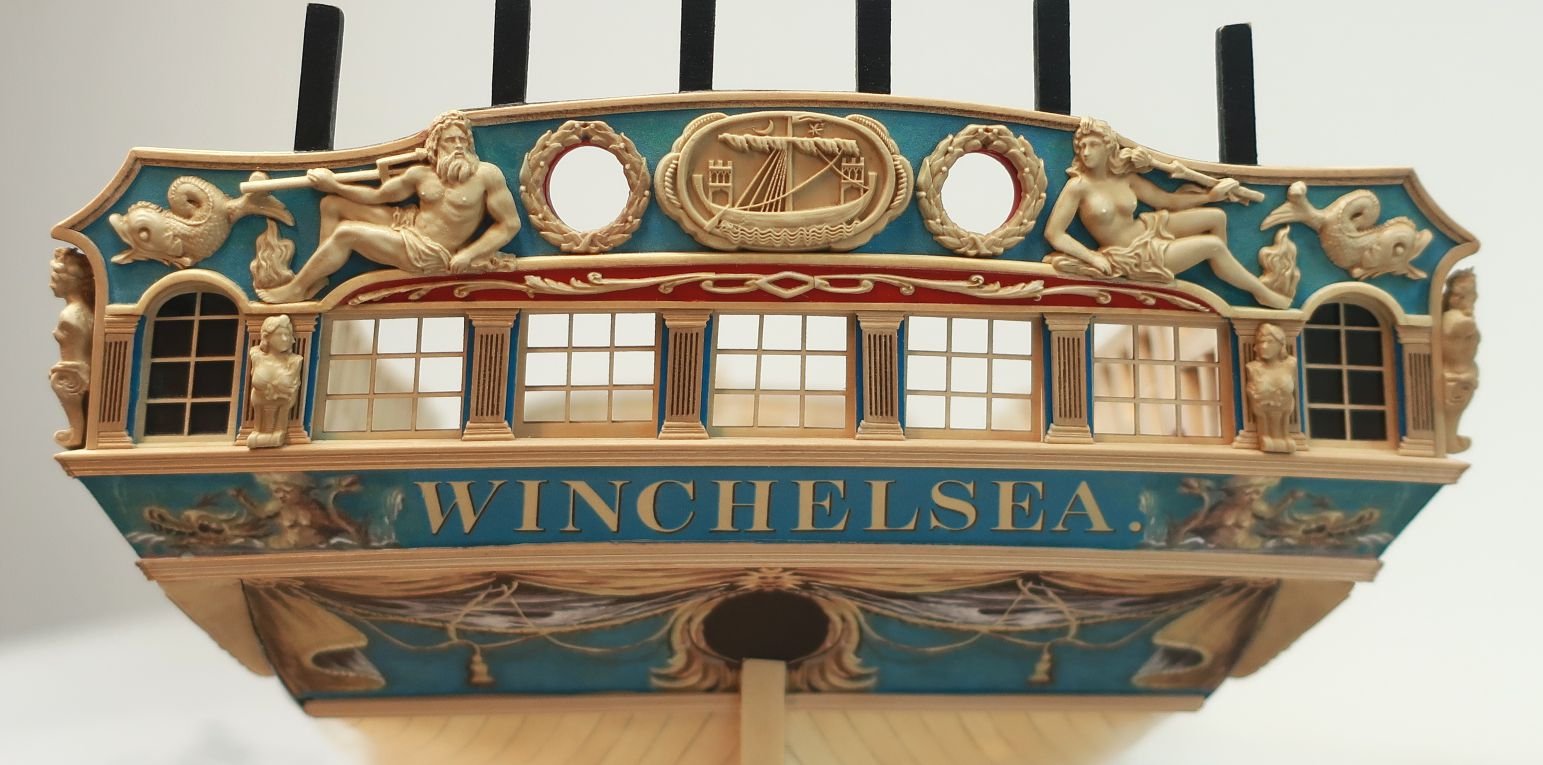

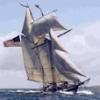

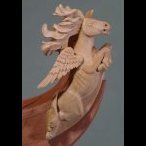

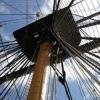

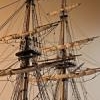



.thumb.jpeg.fc5d633a7b34428fcf19419a73d56d55.jpeg)


